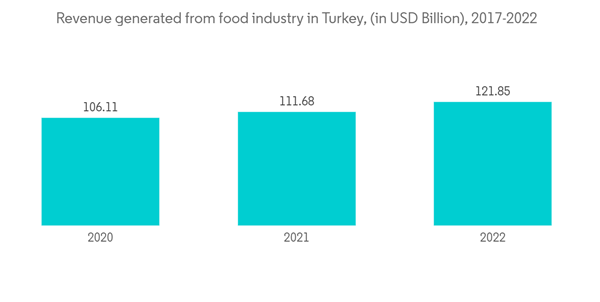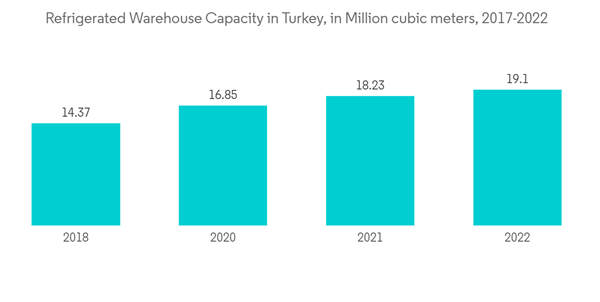Key Highlights
- The COVID-19 pandemic had a positive effect on the cold chain logistics industry. Packaged foods and beverages' growing popularity has helped expand the cold chain as the demand for temperature-controlled warehousing increased. Additionally, the demand for vaccine supply across the country has played a vital role in boosting the market.
- Turkey's strategic position, which connects Europe, the Middle East, and Asia, makes it an ideal transportation and logistics hub. Turkey ranked 8th globally in terms of cold storage capacity. According to the Global Cold Chain Alliance, the average size of the refrigerated warehouse in Turkey was about 729 cubic meters in 2021. Turkey's Refrigerated Warehouse Market Development Index, was 0.242 in 2021, which was higher in the middle-range index countries.
- The growth of cold chain logistics is driven by the demand for food products like dairy, fish, and meat, and the share of these products in the total food revenue is 35%. Other factors are government initiatives toward cold chain infrastructure development.
Turkey Cold Chain Logistics Market Trends
Increase in Demand for Fresh and Frozen Foods Driving the Market
Horticultural production, including fruits, vegetables, and flowers, has been emerging as a major economic activity in Turkey. The diverse ecosystems make it economically possible to grow a wide range of horticultural crops. Turkey is one of the largest producers of hazelnuts, cherries, figs, apricots, and pomegranates. The country also produces quinces, watermelons, cucumbers, green peppers, lentils, pistachios, apples, tomatoes, eggplants, olives, tea, chickpeas, sugar beet, almonds, onions, lemons, grapefruit, cotton, and barley.Turkey has a large domestic market of 85 million people, with more than 15 million living in Istanbul. Therefore, despite Turkey being one of the world's largest exporters of fruits and vegetables, the domestic market is also extremely important.
It is not surprising that recently Turkish farmers have started investing in variety renewal and raising product quality standards to be able to export the maximum outside our region, focusing primarily on India and Southeast Asian countries, the European Union, and rich countries of the Middle East.
An important aspect of state regulation is ensuring temperature regimes by all participants in the fruit and vegetable business when transporting, for example, berries and mushrooms. Although other fruits and vegetables are transported and sold in wholesale markets without refrigeration, the requirement to refrigerate even a limited range is a huge step compared to current practice in the fruit and vegetable markets of the Caucasus and Central Asia, where most retailers violate the temperature regimes.
Government Initiatives Driving the Growth of the Market
The Turkish government has been heavily investing in the cold chain infrastructure of the country, aiding in the increasing warehousing capacity. The government announced it would pour USD 200 billion into infrastructure projects to support its ambitious plan to increase trade levels to USD 1.1 trillion by 2023. Turkey uses the option of fiscal incentives to channel domestic and foreign investments for industrial development and rural-urban integration. These incentives or tax expenditures are usually available to investors to promote private investment activities in selected sectors/regions, depending on the scale of investment. According to the Ministry of Industry and Technology, investment companies can invest in the cold storage sector, which will be considered under the 'Regional Investment Incentive scheme.' Under this scheme, the companies that invest in cold storage may get a tax reduction of up to 50%. The Turkish government also increased spending on infrastructure R&D, while in 2015, the government spent USD 12 billion. In 2020 the spending increased to USD 25 billion.Turkey Cold Chain Logistics Industry Overview
The industry has a handful of players and is largely dominated by organized companies that have a presence in other countries. Havi Logistics, Ekol, Polar Logistics, DHL, and Emran Logistics have made a foothold in the Turkish cold chain logistics market. The Turkish cold chain logistics market has witnessed a gradual increase in the number of value-added service providers because of heightened demand in the local and international markets. This has led cold chain companies to realize the benefits of providing end-to-end services to their customers. Companies have already started providing value-added services to their customers and are planning to expand their service spectrum.Additional Benefits:
- The market estimate (ME) sheet in Excel format
- 3 months of analyst support
This product will be delivered within 2 business days.










